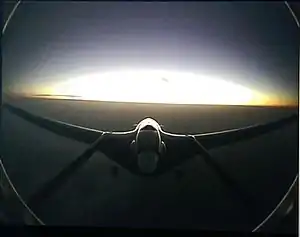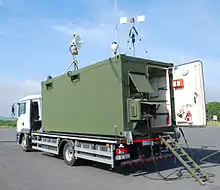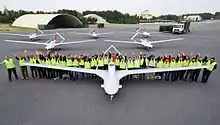Bayraktar Tactical UAS
The Bayraktar Tactical UAS or Bayraktar TB1[1] is a surveillance and reconnaissance unmanned aerial vehicle (UAV) initially developed for the Turkish Armed Forces. It is developed by the Kale-Baykar, a joint venture between the Kale Group and Baykar Technologies.
| Bayraktar | |
|---|---|
 | |
| A Bayraktar Tactical UAS seen through his tail camera at 18,000 feet over the Gulf of Saros in Turkey. | |
| Role | Medium-altitude long-endurance unmanned aerial vehicle |
| National origin | Turkey |
| Manufacturer | Kale-Baykar |
| Designer | Baykar |
| First flight | 2009 |
| Introduction | 2014 |
| Status | In service |
| Primary user | Turkish Armed Forces |
| Developed from | Bayraktar Mini UAV |
| Developed into | Bayraktar TB2 |
In 2014, Bayraktar held the national endurance and altitude record for Turkey's unmanned aerial vehicles (UAV).[2][3] It set a record for autonomous flight endurance when it flew 24 hours and 34 minutes at 18,000 feet on 5 August 2014. It furthermore recorded highest altitude of 27,030 feet on its flight on 14 June 2014 with full payload.[4]
While the Turkish Armed Forces describes Bayraktar as "Tactical UAV Class" to prevent it from being a competitor to the TAI Anka UAV, international standards would classify it as a medium-altitude long-endurance UAV.[5][6] With its 650 kg MTOW and 12 meters wingspan platform powered by an internal combustion engine, Bayraktar is capable of flying at 22,500 feet and loitering for more than 24 hours.
Characteristics
Design


Bayraktar Block B Platform has a blended wing body design with its inverse V-Tail structure. Blended wing body design supports the lifting performance of the overall platform. Thrust is generated through the internal combustion engine placed between the tail booms. Monocoque platform is modular with detachable main items such as wing, tail boom, and V-Tails. All of the fuselage items are mostly made of carbon fiber composite parts whereas precision CNC machined aluminum parts are used at the junction sections of the platform. Fuel is stored within bladder tanks and fuel consumption is automatically balanced with solenoid valves. Variable pitch two blade propeller allows for medium altitude efficient flying.
Ground Control Station is based on a NATO spec shelter unit which is equipped with cross redundant command and control systems. The mobile unit supports for three personnel pilot, payload operator and mission commander. GCS is equipped with redundant Air Conditioners and NBC filtering unit. All hardware inside the shelter is placed inside racked cabinets. Each operator has dual screens in front along with the Operator Interface Software used for real-time command, control and monitoring.[7]
Configuration

Each Tactical UAS is configured with six aerial vehicle platforms, two Ground Control Stations (GCS), three Ground Data Terminals (GDT), two Remote Video Terminals (RVT) and Ground Support Equipment. Each Aerial Platform is equipped with a triply redundant avionics system. Its ground control system's cross redundant architecture allows for pilot, payload operator and mission commander to command, control and monitor the platform.[6]
Digital Flight Control System
Bayraktar has a triple-redundant flight control system with autonomous taxi, takeoff, cruise, landing and parking capability without any external sensor aid. The flight control system is the central main component which conducts sensor fusion algorithms running with the real-time sensor data. Mission specific controls such are handled through the mission control computer system. Aerial platform is guided through various redundant rotary and linear type servo actuators which are designed according to the dynamics of the aerial platform. All of the main airborne avionics equipment software and hardware are developed under the running program so as to achieve utmost performance. Electronic power unit powers the onboard systems supported with triple alternators and smartly balanced lithium ion battery units. A ruggedized heated type camera unit is placed at the tail section of the platform to monitor flight and all payload and telemetry data are recorded to the airborne data recorder. Redundancy architecture of the avionics support for autonomous emergency landings on different airfields if necessary. Sensor fusion algorithms allow for navigation and auto landing even in loss global positioning signals.[8]
Development
In 2007, the Turkish Defense Undersecretariat (SSM) initiated a development program[9] and invited two companies to compete for a prototype demonstration phase of Tactical UAS Program. Bayraktar demonstrated Block A,[10] with its dual redundant avionics system in 2009 with a fully autonomous takeoff and landing capability and was selected as the winner of the program.[11][12] Bayraktar Block B design commenced in early 2012 with the second phase of the program, which covers development and serial production.
Milestones
- Prototype development Phase 1 started in 2007.[13]
- Bayraktar Block A with its 450 kg MTOW and 9 meter wing span made its maiden autonomous flight on 8 June 2009 at Kesan Airport, Turkey.[14]
- Bayraktar Block A completed Phase 1 with day and night flight demonstrations successfully at Sinop Airport, Turkey in October 2009.[15][16]
- Bayraktar Block A was chosen and officially declared as the winner of the competition against Vestel for the ongoing Tactical UAS Program by Defense Executive Committee of Turkey. Meeting was held on 6 January 2010.[17][18][19]
- Phase 2 Development and Serial Production contract signed between SSM and Kale-Baykar Joint Venture in December 2011.
- Phase 2 Development and Serial Production of Bayraktar Block B Program began in January 2012.
- Bayraktar Block B made its first maiden flight at Kesan Airport, Turkey on 29 April 2014.[20]
- Bayraktar Block B achieved national altitude record of 27,030 feet on 14 June 2014 on its test flight.[21][22]
- Bayraktar Block B autonomously took off on 5 August 2014 15:36 and landed on 6 August 2014 16:10 with a total flight of 24 hours 34 minutes and achieved endurance record in Turkish Aviation on its test flight.[23][24][25]
- Bayraktar Block B successfully completed first acceptance tests held on 17–22 November 2014.[26][27][28]
- Bayraktar Block B accomplished its first flight with ADS-B System integrated on board.[29]
- Bayraktar Block B was on live NTV TV Channel[30]
- Bayraktar Block B 2nd system acceptance tests successfully completed on June 18, 2015 .[31][32][33]
- Turkish Police orders 11 Bayraktar Block B platforms.[34]
- Turkish drone ‘Bayraktar’ guides Turkish security forces to kill six PKK members[35]
- Turkish drone 'Bayraktar' guides warplanes to destroy Daesh terrorist targets in north Syria operation[36]
- Turkey's domestically-made armed drone starts patrolling the skies[37][38]
- The 'Bayraktar TB2' completed 60,000 flight hours in September 2018, reaching the average monthly usage rate of 4,500 hours.[39]
Operational history
Syria
On February 12, 2018 The Syrian Democratic Forces said they shot down a Turkish Bayraktar Tactical UAS that was found crashed near Quda, a small town in the Rajo district of Afrin near the Syria-Turkey border.[40]
Specifications
General characteristics
- Length: 6.5 m (21 ft)
- Wing Span: 12 m (39 ft)
- Max Take Off Weight: 650 kg (1,430 lb)
- Power: Rotax 912ULS 100 hp (75 kW)
Performance
- Maximum Speed: 120 knots (220 km/h)
- Cruise Speed: 70 knots (130 km/h)
- Communication Range: 150 km
- Service Ceiling: 22,500 feet (6,900 m)
- Endurance: 24 hours
- Payload: 50 kg
References
- "Selçuk Bayraktar'dan İHA'lı aile pozu". 15 June 2019.
- "Turkey Breaks National Record For Longest Drone Flight". dailysabah.com. 8 July 2014. Archived from the original on 14 August 2014.
- "Bayraktar Taktik İHA Record Flight". suasnews.com. 8 August 2014. Archived from the original on 12 August 2014.
- "Bayraktar breaks tactical UAV endurance record". c4defence.com. 8 July 2014. Archived from the original on 26 December 2014.
- "Turkey Steadily Builds UAV Capabilities". 13 May 2014.
- "Turkey's unmanned ambitions shift up gear". 6 March 2014. Archived from the original on 19 August 2014.
- "Bayraktar's Tactical UAV Demonstrates Outstanding Performance Beyond Its Class". Military Science Intelligence Magazine Turkey. 1 June 2014.
- "Bayraktar Taktik İHA". 8 June 2014. Archived from the original on 12 August 2014.
- "Undersecretariat for Defence Industries Tactical UAV Development Project". SSM. 3 April 2014. Archived from the original on 14 December 2014.
- "IDEF 2011: Bayraktar tactical UAV nears production". Shephardmedia.com. 13 May 2014. Archived from the original on 14 December 2014.
- "Turkish aircraft to replace Herons in intelligence gathering". todayszaman.com. 14 June 2010. Archived from the original on 14 December 2014.
- "From a Hobby to the Peaks of Technology / The Turkish Perspective January-February 2011 Issue 2" (PDF). 1 January 2011. Archived (PDF) from the original on 14 December 2014.
- "Çaldıran'ın yapım öyküsü / Yalcin BAYER, Hurriyet". 10 March 2009. Archived from the original on 14 December 2014.
- "Bayraktar Block A Maiden Flight 08 June 2009". 6 July 2009. Archived from the original on 5 May 2016.
- "'Heron'a karşı 'Çaldıran', Hurriyet". 10 January 2009. Archived from the original on 12 August 2014.
- "Kale Group completes test flights for a new tactical UAV". 27 July 2010. Archived from the original on 19 August 2014.
- "İşte Heron'un Türk rakibi / Vatan Gazetesi". 28 June 2010. Archived from the original on 27 October 2014.
- "Defense Executive Committee Decision". 1 June 2010. Archived from the original on 12 August 2014.
- "Türk Heron'lar Gabar'da doğdu". 7 March 2010. Archived from the original on 27 October 2014.
- "Cumhuriyet tarihinde bir ilk! / Vatan Gazetesi". 5 February 2014. Archived from the original on 8 August 2014.
- "Dünyanın en gelişmiş İHA'sını Türkler yaptı / Star Gazetesi". 5 July 2014. Archived from the original on 6 October 2014. Retrieved 8 August 2014.
- "İnsansız Hava Aracı'nda Türkiye irtifa rekoru!". 17 June 2014. Archived from the original on 12 August 2014. Retrieved 8 August 2014.
- "Yerli İHA'dan uçuş rekoru / Vatan Gazetesi". 8 June 2014. Archived from the original on 8 August 2014.
- "Bayraktar Taktik İHA rekorlara doymuyor! / Star Gazetesi". 8 June 2014. Archived from the original on 8 August 2014. Retrieved 8 August 2014.
- "Turkish Tactical Drone Ready for Delivery". Retrieved 2015-08-22.
- "Bayraktar'a TSK'dan kabul". Archived from the original on 27 November 2014. Retrieved 24 November 2014.
- "Milli İHA kabul testlerini geçti". 25 November 2014. Archived from the original on 4 December 2014.
- "Turkish drone, Bayraktar II, to be delivered to the Army in two months". Archived from the original on 2015-09-23. Retrieved 2015-08-22.
- "İlk defa milli bir hava aracı ADS-B sistemi ile uçuş takibi yapıldı". Kokpit.Aero. 2015-04-16. Archived from the original on 2015-05-05.
- Bayraktar TB2 Denizkurdu Tatbikatinda NTV Ana Haber, retrieved 2015-07-22
- "Kara Kuvvetleri'ne Bayraktar İHA teslimatları tamamlandı". kokpit.aero. Archived from the original on 2015-07-22. Retrieved 2015-07-22.
- 2011, Anadolu Ajansı (c). "Milli İHA'ların 2. paketi de teslim edildi". www.aa.com.tr. Archived from the original on 2015-06-22. Retrieved 2015-07-22.CS1 maint: numeric names: authors list (link)
- "12 yerli İHA, TSK envanterinde! | GAZETE VATAN". Archived from the original on 2016-05-15. Retrieved 2015-07-22.
- "BUSINESS - Turkish police ramping up drone purchases in fight against terror". Archived from the original on 2015-08-22. Retrieved 2015-08-22.
- "Turkish drone 'Bayraktar' guides Turkish security forces to kill six PKK terrorists". 2016-09-22. Archived from the original on 2016-10-02.
- "Turkish drone 'Bayraktar' guides warplanes to destroy Daesh terrorist targets in north Syria operation". 2016-09-07. Archived from the original on 2016-10-02.
- "Turkey's domestically-made armed drone starts patrolling the skies". 2016-09-04. Archived from the original on 2016-10-02.
- "Turkey's first domestically produced armed drone takes off". 2016-09-05. Archived from the original on 2016-10-01.
- "BAYRAKTAR TB2'nin Deniz Kuvvetlerine de Teslimatı için Gün Sayan Baykar, AKINCI ile Oyunun Kurallarını Bir Kez Daha Değiştirmeye Hazırlanıyor". Military Science & Intelligence. 2018-09-13. Archived from the original on 2018-09-28. Retrieved 2018-09-27.
- "SDF claims it shot down a Turkish Bayraktar drone that crashed in Afrin". The Defense Post. 2018-02-12. Archived from the original on 2018-02-13.
External links
| Wikimedia Commons has media related to Kale-Baykar Bayraktar Tactical. |
- Baykar Aerospace Industries
- Baykar Research Activities Documentary Video
- Bayraktar Block B Technical Brochure
- Bayraktar Block B Preliminary Design Review Documentary / May 2012
- Bayraktar Block B Maiden Flight / 29 April 2014
- Bayraktar Block B Endurance Record Flight / 05-6 August 2014
- Bayraktar Block B Altitude Record Flight / 14 June 2014